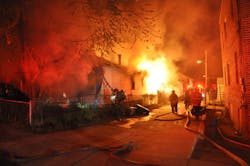Report Finds Flaws in Response to D.C. Arson Fire
A recently issued report on the D.C. fire department's response to a fire in an abandoned house that severely burned five firefighters in April 2011 makes new recommendations on training, equipment and protocol.
Several fire companies that responded to the fire in the 800 block of 48th Place Northeast failed to properly execute many basic but critical tasks, including proper set-up at the scene and correct communication, according to the department-issued report. Responders ended up on different radio channels, so information about the quick spread of the fire was not shared with everyone.
Soon after firefighters arrived at the one-story wood-framed, single-family home, part of the roof collapsed, forcing heat and debris on a search crew inside.
The problematic responses highlight the need for regular and continued on-the-job training, officials said.
Starting in 2011, the department has had "a noticeable drop-off in training," D.C. Firefighters Association President Ed Smith said.
He hopes the recommendations in the report will lead to more fire simulation training at the department's training academy, especially on techniques used to identify and deal with flashovers, which occur when a room fills with heat and bursts into flame - a situation that caused injuries during the 48th Place fire.
"That's something that has to be experienced. It's not learned in a classroom," Mr. Smith said. "Anything that's going to make my members safer, I'm all for."
The report does not lay out a timetable for implementing any of the recommendations, but notes that several of the recommendations are similar to those made - but still not implemented - in previous reports written after fatal fires.
A fire department spokesman did not respond to a request for comment about the report or any sort of priorities for implementing the recommendations.
Three officers who oversaw fire operations at the 48th Place fire were detailed to the department's training academy at the beginning of July, but their roles there were unclear.
"In any profession, retraining is critical," D.C. Council Chairman Phil Mendelson said. "I think our firefighters are good, and I think they are well trained, but there is always a value to retraining."
In addition to training recommendations, the report also encourages the department to develop a system of identifying and tracking vacant buildings. The house - set alight by a serial arsonist who was later caught and convicted - was not occupied at the time of the fire, but that was not known to first responders.
The unusual interior layout also caused confusion for firefighters who entered the house, and the report recommends the additional purchase of thermal imaging cameras to increase firefighters' awareness of the interior structure of buildings they enter. Mr. Smith said the department already owns some thermal cameras.
When some of the injured firefighters were taken to hospitals, medics were unable to administer drugs intravenously because of their burns. As a result, the report recommends making both pain-killing "lollipops" and intranasal medications available on ambulances.
With the 500-page report released just last week, Mr. Mendelson, a Democrat, said it is too soon to tell what the Committee on the Judiciary will do with the recommendations.

